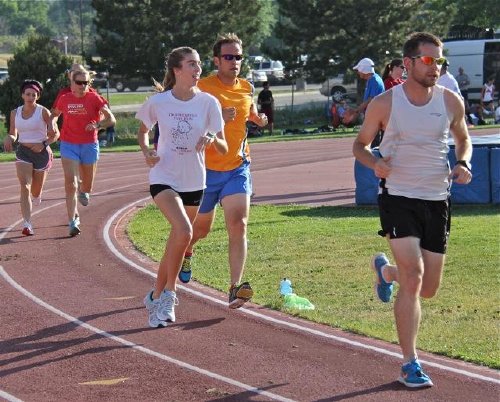
As spring moved in with warmer temperatures and budding flowers, it also brought a noticeable increase in runners hitting the trails and roadways to up their endurance, pace and distance. Yes, Boulderites, the first wave of 2013 road races is upon us.
You may be a newbie to running, or a somewhat seasoned runner with a few long races under your running shoes, or perhaps you are a veteran runner looking to develop a new personal best. Regardless of fitness level and running prowess, tips from experts can help runners of all levels better their performances. Here, three local personal trainers offer some solid advice on training and nutrition to help up stamina and hit personal goals.
ALL RUNNERS TAKE HEED
Whether you’re preparing for your first race or have been training for years, coaches and trainers consistently repeat the same fundamental advice — be mindful about nutrition and calorie intake, ensure that you’re allowing for proper rest and recovery time and, regardless of level, spend time working with a coach or personal trainer. Following these recommendations can help prevent injury and improve performance.
“Treat yourself like an athlete,” says Michael Cancilla, personal trainer and group instructor for the city parks and recreation departments of Boulder and Longmont. Cancilla explains that eating well and getting proper rest are essential to performance.
In fitness, the “window of opportunity” to eat occurs 30-60 minutes pre- and post-workout, says Cancilla. Within these windows, consume foods high in protein and quality carbohydrates, such as apples, bananas, almonds, yogurt, peanut butter and whey protein shakes.
Disregard hype about carb-loading and, instead, eat wholesome and healthy portions of carbohydrates, fat and protein, says Jerry Hernandez, health and wellness coordinator for the YMCA of Boulder Valley Mapleton Center. Protein, particularly, is important for athletes, as cardio depletes lean muscle mass and protein helps to repair and build muscle and supports bone health.
Learn your basal metabolic rate — the amount of calories you burn daily by just sitting idly — and then tack on the calories required to meet the energy needs of your training, says Matt Hoskins, performance fitness coach and owner of Cheetahfit Training & Wellness Center. Hoskins explains that many athletes blow it on calories, and inefficient calorie intake can lead to the body depleting rather than building muscle.
“Many athletes think we can eat like normal people and still train and compete well by maybe throwing in a gel,” says Hoskins. “But we really need to up calorie intake to meet energy needs.”
Stay hydrated to avoid cramps, and maintain consistent water intake throughout the day, not just within the hours before and after a workout.
All trainers stress the importance of avoiding or aggravating injury and explain that recovering properly is an important part of the training process. Cancilla recommends increasing the quality of resting periods and sleep and staying off the feet when not training. He also suggests periodic spans of “active recovery” after weeks of peak training.
“You ramp up for a few weeks and then reduce your activity for a week — this is called active recovery, which means you give your body a breather while it’s still actively working,” he says.
“Recovery time is key,” agrees Hoskins, who recommends prioritizing hours and days off. He suggests athletes identify minimal recovery time before considering training volume and creating their training schedule.
“Recovery is so important,” says Hoskins. “With out it, you are constantly breaking down and stressing the system.”
Finally, all three trainers emphasize the value of working with a trainer or coach. For beginners, an expert provides the guidance needed to develop proper form, running gait and technique, all of which can maximize performance and help avoid injuries. People new to fitness can also learn a wide variety of exercises.
At intermediate and advanced levels, a trainer provides a more structured program that focuses on workouts with real intention and purpose, explains Cancilla. A trainer can also be imperative to helping an athlete (re)discover proper technique and form. People begin running, and some realize they enjoy it and have an aptitude for it. They begin training more often and harder and may end up participating in elite races without any formal coaching. It takes 500 repetitions of a movement to engrain a pattern into the nervous system, says Hoskins, but it takes roughly 5,000 repetitions of a new movement to correct an old pattern. This is where a trainer becomes vital in helping an athlete pinpoint and correct inefficient and potentially harmful mechanics.
Every individual is different and is going to need a specific training regimen, says Hoskins. It is rarely so simple as a couple of weeks — if the pattern has been engrained for many years, a body may need a total rebuild.
RUNNING GREEN
You’ve been saying for years that you’re going to get in better shape and run the Bolder Boulder — the difference between past years and today is that now you really mean it.
Beginners should focus on long-slow duration training and run at an easy pace twice a week for at least 45 minutes. This creates a baseline for all endurance athletes as their bodies adjust to running long distances, explains Hernandez. It’s the least intense mode of training, but it’s the foundation needed to get a body used to the stress of more advanced, subsequent training.
Developing a strong core and engaging in resistance training is essential.
“Your core is your foundation,” explains Hernandez. “If you don’t have a strong core, you’re likely going to be weak at everything you try to do. It affects the performance of all athletes, from baseball pitchers to football players to cyclists. And it certainly affects runners.”
While Hernandez says that basic crunches and sit-ups are important to core health, he suggests incorporating other exercises into workouts, such as planks, bird dogs and reverse bridges. He also stresses the importance of working the obliques and using slow, controlled movements.
For resistance training, hit the gym a couple of times a week to engage in exercises such as dead lifts and squats.
TREADING TO TRANSITION
You’ve run a few races longer than a 5K and hit a trail or treadmill for a 5-mile run at least three or four times a week, but have you advanced to the status of intermediate runner? To be classified as intermediate, a person should have a basic fitness level that includes running 5 miles at least three to four times a week, a longer 10-mile run at an easy pace once a week, should be easily hitting 15-20 miles a week and must be coachable, explains Cancilla.
The primary focuses of intermediate runners are to increase mileage, pace and endurance. To do so, Cancilla suggests not only training harder, but also smarter. He recommends increasing mileage no more than 10 percent a week and sprinkling in some speed work to slowly get used to a faster pace for longer periods of time. Most important for this level, though, is to increase the long run. Cancilla suggests working within an 18-week training program that starts with a 10-mile-long run and gradually increases distance to 20 miles around week 11. He also suggests peaking at a total of 50 miles a week and to get there by strategically adding a mile or two weekly.
“The idea is to get time under your feet,” explain Cancilla. “But, you want to do it gradually so your body gets it and you don’t end up overwhelmed.”
Also, be prepared to cut your mileage and training way back in the weeks just before a long race, says Hernandez. This allows for necessary muscle repair and body recovery.
For about half of your training regiment, one day should be reserved for some type of cross-training that keeps you off your feet, like swimming or cycling, says Cancilla. Stay focused on straightforward, linear movements. At about week nine, Cancilla recommends replacing the day of crosstraining with either rest or a 3- to 4-mile run to increase weekly mileage. He suggests returning to cross-training during the off-season to shore up weaknesses and imbalances.
THE VETERAN ROAD RUNNER
You’ve racked up impressive times and mileage and may have won an elite race or two, but that alone may not be enough to qualify you as an advanced runner, says Hoskins, who coaches world-class athletes. A runner must pass a biomechanics test — meaning that there is synergy between mind and body and that the body is performing economically and efficiently. They must be able to learn new movements and make changes. A key attribute of an advanced runner is coachability.
At the advanced level, efficiency, economy of motion and a focus on compensating for weak areas of performance are key.
“Focus on proper running mechanics in a meaningful way,” Hoskins says. He explains that it’s imperative that athletes train their brains to dial into their own biomechanics and form moment to moment. Doing so makes it possible to create better running economy and efficiency of motion and enables athletes to develop the ability to run faster using the same energy expenditure once used to produce a slower time.
“Focusing on the brain-to-body connection to achieve running economy also leads to less injury and better recovery,” Hoskins says. “If the advanced runner is biomechanically efficient, several things occur. The body is in alignment, creating less stress on the muscles and joints. Power leaks are eliminated, particularly in the hips, and that leads to better power and stability.”
Respond: [email protected]














